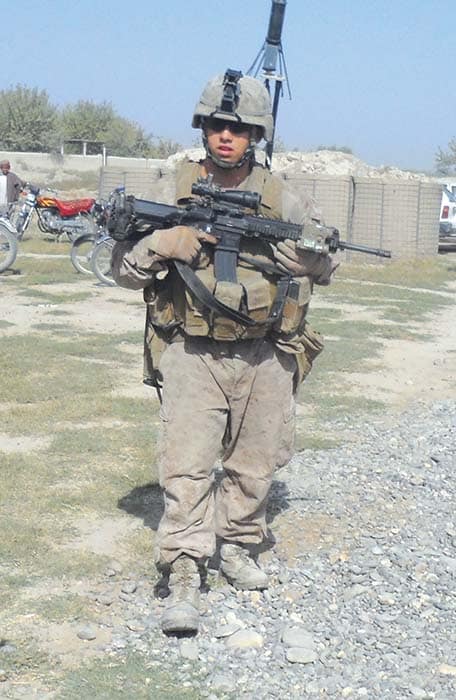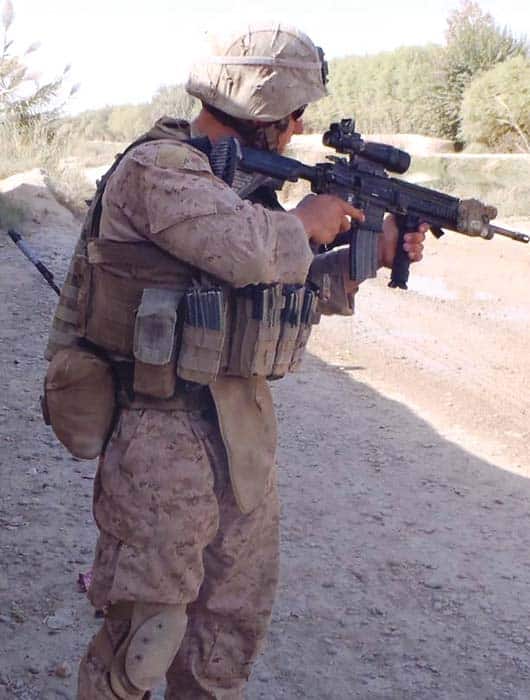Marine squad takes a break during a company raid for a photo while others provide security in the background. All Marine patrols became less common after the local security forces took on more responsibility for their areas. Two on the far right and the middle Marine sitting all have M27s. The right most M27 gunner is using a one point while the two left M27 gunners have three points and one of them the ECM device. Two Marines on the far left have M4s with M203s because they are squad leaders. Third man from left is a civilian Law Enforcement Program adviser. These men were American civilians with police backgrounds sent over to help with training and structuring the Afghan Police. Their weapons and issue equipment is not through the Marine Corps, thus they have different weapons and gear. This adviser has a Bushmaster M4 with Aimpoint scope.
By Miles Vining
In a previous issue of Small Arms Review, the author discussed the Low Rate Production (LRP) M27 Infantry Automatic Rifle (IAR) that had been trialed in various units throughout the Fleet Marine Force. Having covered training experience and initial issue of the weapon, this article will cover how the LRP M27 fared in its true testing environment, Afghanistan. From late May to December 2011, 1st Battalion, 9th Marine Regiment out of Camp Lejeune, North Carolina was deployed to Helmand Province, Afghanistan. There the battalion conducted counter insurgency operations and assisted in providing security and stability throughout the region. 1st Battalion, 3rd Marine Regiment out of Kaneohe Bay, Hawaii was deployed in the Area of Operations south of 1/9 and was similarly equipped with the M27 IAR. Profiled in the June issue of Marine Corps Times, they were the first Marine infantry battalion to deploy with the M27. Readers must note that this covers the Low Rate Production M27s, of which there were only 458 produced for down range evaluation. Although these M27s are still in service with the Marine Corps, there were a number of design changes that have been made and this article does not reflect those design changes. It is very specifically about the LRP rifles and shall not be confused with the rifles currently in service throughout the Marine Corps. There are many differences between the LRP version and the current version, all of the issues addressed in this article have been changed in the current service version.
In May of 2011, Commandant of the Marine Corps officially confirmed the replacement of the M249 SAW with the announcement of a purchase of 4,476 M27 IARs. The M27s will replace current SAWs on a one to one basis, with infantry companies retaining some SAWs for supplementary purposes. The M249 served the U.S Marine Corps well since its adoption in 1984. In recent years, issues of reliability and portability had taken their toll on the weapon in its use within the War on Terror in Iraq and Afghanistan. After holding the Infantry Automatic Rifle competition, the Marine Corps selected the modified Heckler & Koch (H&K) 416 from the Colt and FN Herstal contenders. Several units were tasked with overseeing how the M27 fared downrange, 1/3 and 1/9 being two of the five.
The June heat of southern Afghanistan is warm enough to make the glue on envelopes melt and dehydrate anyone within hours of prolonged exposure. In Helmand province, the heat dries up fields and canals, creating ankle-rolling terrain and crops, drenching men in sweat from passing through. Winter nights become cold and the wind unforgiving. This is where the rural Afghan population and Taliban coexist and where 1/9 with the M27 went to work. Mobile convoys routinely crisscross the AO and foot patrols exceed 10 or more kilometers with a full combat load of ammunition, water, armor and Kevlar helmets; along with Counter Improvised Explosive Device (CIED) Electronic Countermeasure (ECM) packs averaging 20 pounds. Here the M27 proved its worth, both in and out of kinetic engagements.
Of the engagements involving 1/9 Marines, the M27 proved to be worthy and reliable. Most took place beyond 100 or more meters and against small numbers of insurgents. The need to establish superior firepower was often not necessary. But this did not mean the M27 gunners brought any less ammunition on patrols. While the combat load for Marine riflemen with M16A4s is a standard 6 magazines in pouches and 1 in the rifle, M27 gunners loaded twice or more of that amount with 21 issued brown follower magazines. Many simply added more magazine pouches to their scalable plate carriers, with each pouch holding 2 magazines. Marines who wore patrol belts would put additional pouches on those as well. Pouches intended for 100 round SAW sacks were instead used to fit 6 thirty round magazines. Some Marines also used magazine couplers on M27s for a quicker reload but because Marines carry their weapons around everywhere and not just on patrol, this become bulky and cumbersome.

Being in-country certainly proved the M27s versatility and standardized fit. For Marines working with equipment (vehicles, weapon racks) already fitted for the M16A4, the M27 fit just as well with the butt stock fully extended. Drivers and turret gunners had no issues stowing their M27s nearby, fitting it in crevices that could not accommodate the SAW. Considering the Marines were in southern Afghanistan to advise the ANA (Afghan National Army) and AUP (Afghan Uniformed Police) forces, most foot patrols were partnered. Thus, instead of having a standard Marine squad outside the wire (although this also occurred), partnered patrols would consist of several Marines and a larger number of local security forces. Instead of a Marine carrying the squad’s firepower as a separate entity in the patrol’s composition, he could now carry more weight such as the ECM device, metal detector, and other mission essential gear regardless of his primary weapon. Designations of a separate patrol leader, point man, or assistant patrol leader disappeared as the M27 allowed Marines to take on additional duties. Instead of making sure the point men or the first in a stack didn’t have an open bolt weapon, leaders could have more freedom with their M27 gunners. Let it be of note that some smaller units that weren’t issued M27s, carried SAWs in their place.
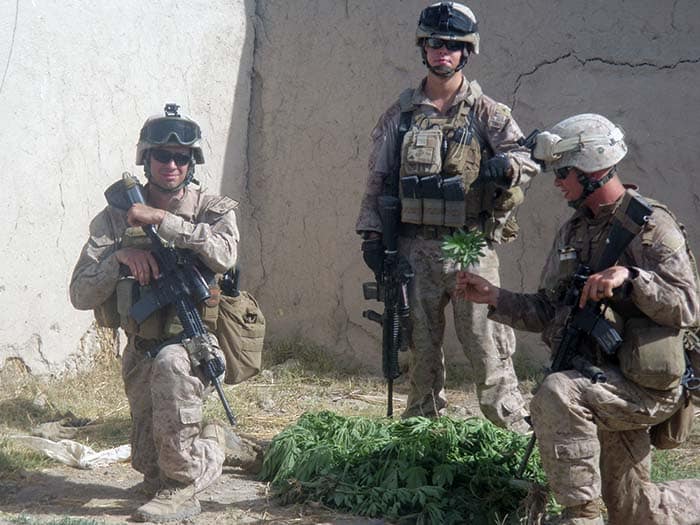
Many M27 gunners used the issued 3 point sling. Most attached it to the rifle just like an M16A4, to the stock and the upper part of the hand guards. Some did away with the Velcro stock fitting and threaded the sling through the plastic sling swivels on the collapsible stock. Another method was to move the issued M27 sling swivel closer to the upper receiver on the RIS and attach the sling there for more movement with the M27. A disadvantage to the three point sling and one points mounted to the stock is that the butt stock is removable by simply depressing the position lever. If the stock comes off accidentally with the sling still attached, the user risks the rifle and a possible chance of losing it as well. Traditional two point slings have been used but are very rare, some gunners opting for the old padded SAW two points.
Slings bring up the issue of interchangeability between the M27 and M16A4/M4. All one point mounts designed for the M4 carbine will fit the M27, due to the fact that the buffer tubes have similar parameters. They might not work as well due to the additional weight of the M27, SDO and AN/PEQ 16. All rail attachments as well as the buttstock itself are interchangeable with an M4, but an issue M4 butt stock or Vltor butt stock with the Milkor Mk.32 Grenade Launcher cannot fit an M27 buffer tube. Most magazines on the market are interchangeable including H&K steel magazines, EMags, and PMags (if modified, but this is highly discouraged). Not to argue that the issue brown follower magazines are of a lesser quality or reliability. These magazines certainly proved their worth over the old green follower magazines and were more reliable. On higher capacity, Surefire was contacted in April 2011 by the author and a representative said that the 100 and 60 round magazines would not function but they were working on a new design. Since then, these magazines have been proven to work in the M27 but none have been issued in country. At least one Marine has used a 150 round Armatac drum successfully. More important than magazines, parts that should not be interchanged at all are the buffer springs and buffers themselves.
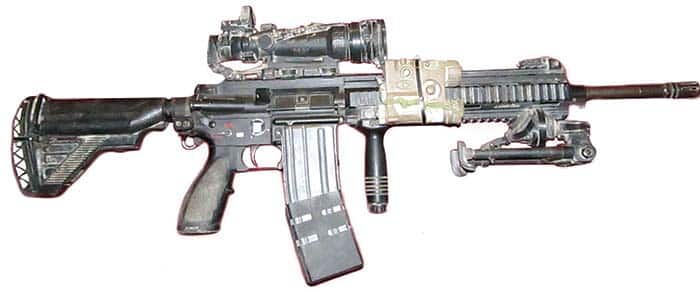
When 1/9 returned from predeployment exercises in Twenty Nine Palms, California, the chief complaints about the M27 were the lack of a sturdy bipod. ironically, 1/9 actually had an entire store of the issued Harris bipods, but due to logistical chains, had not issued them out to the line units. The author personally saw this store on return from Afghanistan. Some of the bipods privately purchased by gunners include, Harris, Versa Pod, CAA, imitation SAW bipods, with Harris being the most popular. Versa Pod bipods are extremely versatile because they can be taken off easily around a patrol base or on a mobile mission but can be attached when going on patrols. CAA bipods were rugged and solid but lack height. Imitation SAW bipods barely worked and ended up being detached.
Regarding cleaning practices, Marine riflemen are known to operate in extremely harsh and remote environments, keeping their weapons and equipment impeccably clean and functioning. Afghanistan was no exception for the Marines of 1/9. Although all M27 gunners have had prior experience with maintaining the M16 series of weapons and the M27 is very similarly. Of lesser note are the SDO and RMR. Unlike an ACOG on M16A4s and M4s, the SDO honeycomb and lens cap must be screwed off for disassembly. Unless the gunner has already lost his honeycomb, dust can collect on the objective lens without being readily noticed due to the honeycomb’s concealing nature. Also, the reticule on the RMR can become clogged and dim if the projector is not wiped down.
For its second combat deployment (1/3 arrived in Afghanistan 2 months before 1/9), the M27 fulfilled the expectations of an H&K weapon, measuring up to high standards and expectations. The few issues it did have are covered above and in detail. The following are some recommendations for improvement. Not to repeat an issue, but the magazine capacity and bipods need to change. 1”-13” Harris bipods with Larue RIS adaptors are going to be issued en masse but there is no current intent to increase the magazine capacity. Although Harris Bipods are an industry standard and a proven bipod system, something more suited for machine gun purposes and rough use should be considered. Harris Bipods have external springs, snub nosed feet and are made for sturdy, long range rifles. Something along the lines of the Versa Pod with sled feet or even modified SAW bipods might be more fitting.
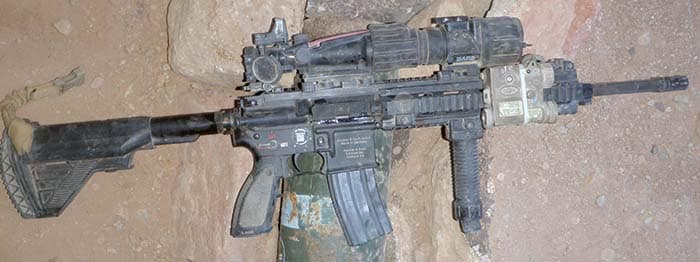
Replacing a belt fed, quick-change barrel, light machine gun with a magazine fed, fixed barrel automatic rifle reflects the changing nature of the American military. This has already been experienced by many countries such as the UK with the L96 LSW, Russia with the RPK and China with the QBZ series. Similar to the reduction of caliber from the 7.62 M14 to the 5.56 M16A1 or the replacement of the M1911A1 by the Beretta M9, this transition is still in its infant stages of development and use. Some years of full procurement and understanding how to fully apply it tactically are currently in the making. This change has many, especially within the Marine Infantry community, bemoaning the loss of the venerable SAW to a fundamentally different weapon. As did many over the M9 and M16A1. Through out its first deployments with 1/9 and 1/3, it has served its users well. Only time will tell if it will continue to do so in future service and conflicts.
Special thanks to Liza Ponomarenko, and the Marines and Corpsmen of 1st Platoon, Charlie Company at Patrol Base Loy Kolay,
| This article first appeared in Small Arms Review V20N1 (January 2016) |





